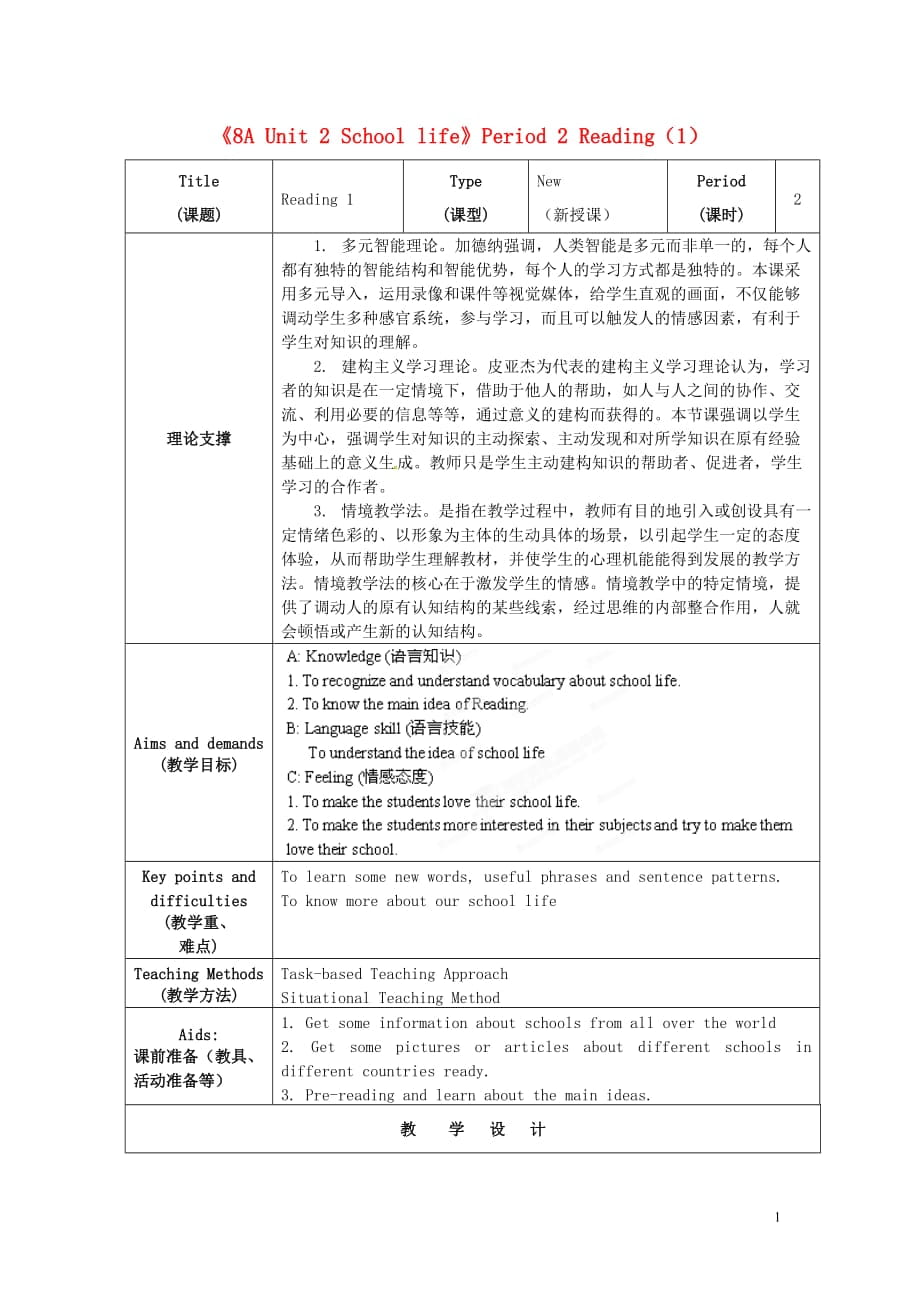《江蘇省海安縣大公初級中學八年級英語上冊《8A Unit 2 School life》Period 2 Reading(1)教案 牛津版》由會員分享�����,可在線閱讀��,更多相關《江蘇省海安縣大公初級中學八年級英語上冊《8A Unit 2 School life》Period 2 Reading(1)教案 牛津版(5頁珍藏版)》請在裝配圖網上搜索����。
1、
《8A Unit 2 School life》Period 2 Reading(1)
Title
(課題)
Reading 1
Type
(課型)
New
(新授課)
Period
(課時)
2
理論支撐
1. 多元智能理論���。加德納強調���,人類智能是多元而非單一的�,每個人都有獨特的智能結構和智能優(yōu)勢�,每個人的學習方式都是獨特的。本課采用多元導入��,運用錄像和課件等視覺媒體�����,給學生直觀的畫面����,不僅能夠調動學生多種感官系統,參與學習����,而且可以觸發(fā)人的情感因素,有利于學生對知識的理解��。
2. 建構主義學習理論�����。皮亞杰為代表的建構主義學習理論認為��,學習者的知識是在一定情境下,
2�、借助于他人的幫助,如人與人之間的協作�、交流、利用必要的信息等等��,通過意義的建構而獲得的�����。本節(jié)課強調以學生為中心�����,強調學生對知識的主動探索���、主動發(fā)現和對所學知識在原有經驗基礎上的意義生成。教師只是學生主動建構知識的幫助者�、促進者,學生學習的合作者��。
3. 情境教學法�����。是指在教學過程中,教師有目的地引入或創(chuàng)設具有一定情緒色彩的��、以形象為主體的生動具體的場景��,以引起學生一定的態(tài)度體驗�����,從而幫助學生理解教材����,并使學生的心理機能能得到發(fā)展的教學方法。情境教學法的核心在于激發(fā)學生的情感���。情境教學中的特定情境����,提供了調動人的原有認知結構的某些線索���,經過思維的內部整合作用���,人就會頓悟或產生新的認知結構。
3���、Aims and demands
(教學目標)
Key points and difficulties
(教學重�����、
難點)
To learn some new words, useful phrases and sentence patterns.
To know more about our school life
Teaching Methods
(教學方法)
Task-based Teaching Approach
Situational Teaching Method
Aids:
課前準備(教具�、活動準備等)
1. Get some infor
4、mation about schools from all over the world
2. Get some pictures or articles about different schools in different countries ready.
3. Pre-reading and learn about the main ideas.
教 學 設 計
課前延伸
1. To listen to the tape and preview the new words of the text.
2. To read the text and get a
5�、general idea.
3. To find out the difficult points.
(個人思考,小組討論�����,待課上求助)
4. Surf the Internet for some information about schools in different countries
讓學生通過課前自學����,小組內的團結合作解決預習中的一些問題�,為上課做準備
Teaching Plan
(授課計劃)
Studying Plan
(學習計劃)
Aims
(設計意圖)
課
內
探
6、究
學
Step One Warming up
1. Show the students some pictures of schools in Britain and the USA.
2. Talk about different words which have the same meaning in Welcome to the unit.
1.檢查課前預習:各組代表交流對school life in different countries的了解情況����,再提出組內無法解決的疑難問題。2. 老師設問�����,導入新課。
Step Two Presentation
(
7�����、Pre-reading)
1. Teach the new words.
Nouns: subject hero taste article
Verb: sew practice taste
Adjectives: tasty close
(With the help of some pictures.)
2. Explain the context of the reading passage.
(John and Nancy are saying something about their school lives )
1.通過單詞競賽���,檢查預習單
8���、詞情況,為接下來的環(huán)節(jié)做好鋪墊���。(作好過程中激勵性評價)
2.采用相互問答或對話的形式���,在語境中運用生詞,激發(fā)學生興趣���,對Reading內容有進一步的感性認識���。
導
Step Three Practice
( While-reading)
1. Ask students to listen to the passage, paying attention to the pronunciation, and make some of them to read the paragraphs aloud.
2. Listen to the tape and answer the
9、 following questions.
(1)Which year is John in?
(2)What kind of school is Woodland School?
(3) Does John have lessons together with girls in his school?
(4)What subject does John like best?
(5)What does John learn at school?
(6)What activity does John have every year?
(7)What can John do dur
10����、ing the Reading Week?
(8)Why do students like the Reading Week?
(9)How old is Nancy?
(10)What grade is Nancy in?
(11)When do students have driving lessons at school in the USA?
(12)How does Nancy go to school every day now?
(13)What sport does Nancy love?
(14)How often does Nancy play softbal
11�、l?
(15)What activity does Nancy join every Monday?
(16)In the Buddy Club, Who often helps Nancy?
(17)Which grade is Julie in now?
2. Listen to the tape again and judge the following statements. Write a T if it is true, write an F if it is false.
(1)In a mixed school, boys and girls have lessons
12���、 together.
(2)John’s favourite subject is English.
(3)Students at John’s school can read magazines during Reading Week.
(4)Students must not talk in class during Reading Week.
(5)You can have driving lessons at the age of 16 in the USA.
(6)Nancy plays softball twice a week.
(7)Every Monday,
13��、 Nancy meets Julie to talk about school.
(8)Nancy and her friends go to shopping malls at lunchtime.
3. Read the passage together and complete the following articles according to it.
(A)John is in a British school. It is _____Woodland School. It is a _____ school. That means boys and girls have
14���、lessons ____.John’s favourite ____ is Home Economics. He likes learning how to _____ and ____. Now he knows how to make _____ and ____ meals.
(B)Nancy is 14 years old. She is in an _______ school. His brother is 17 years old. He had ____ lessons in school last year. Now he can _____her to school ev
15、ery year. It’s _____ than taking the bus. Nancy likes playing ____. Every Monday she goes to a “_____ ____”. There she can make some friends. Julie is her ___. She helps Nancy a lot. So Nancy thinks Julie is her _____.
4. Check the answers.
5. Read together.
尊重學生的個性差異��,分層要求����。在學生自學過程中,教師通過觀察���、詢問,有計劃地
16�����、點撥學困生���,鼓勵其大膽質疑�;有針對性地向優(yōu)生提出深層次的問題,使他們的聰明才智得到充分發(fā)揮����。
1. 通過對學生的聽讀訓練,培養(yǎng)其搜索有用信息的能力�。
2. 強化聽說訓練,提高學生對文章細節(jié)的理解和推斷能力�。繼續(xù)進行過程性評價。
練
Step Four Production
(Post-reading)
1.Enjoy a video about a school in Shanghai
2.Questions:
(1)Do you want to study in such a school?
(2) If you do, what can you do an
17�����、d learn?
(In groups.)
3. A report
(1) Each group chooses one student to come to the front to give us a report.
(2) Give some presents to the best group.
欣賞video并會用英語談論video內容���,培養(yǎng)學生的口語表達能力����。以四二一小組為單位�,合作交流,取長補短�����,集思廣益��,推優(yōu)向全班展示成果。(教師巡視��、了解����,點撥有困難的學生大膽開口,引導優(yōu)生發(fā)揮才智�。充分體現面向全體學生,注重他們整體素質的提高�����。)
課后提升
Step Five
18���、 Assignment
1. Recite all the new words.
2.Find more information about schools all over the world
3.Write an article about the life of the school you know
控制作業(yè)量�����,既落實雙基��,又重視知識面的拓寬和能力的提升。(關心學生的認知發(fā)展)
Blackboard design (板書設計)
School Lives
Phrases:
my favourite subject
one of my heroes.
learn how to sew
practice doing sth.
taste good/ bad
cook healthy and tasty meals
a close friend
5
 江蘇省海安縣大公初級中學八年級英語上冊《8A Unit 2 School life》Period 2 Reading(1)教案 牛津版
江蘇省海安縣大公初級中學八年級英語上冊《8A Unit 2 School life》Period 2 Reading(1)教案 牛津版

